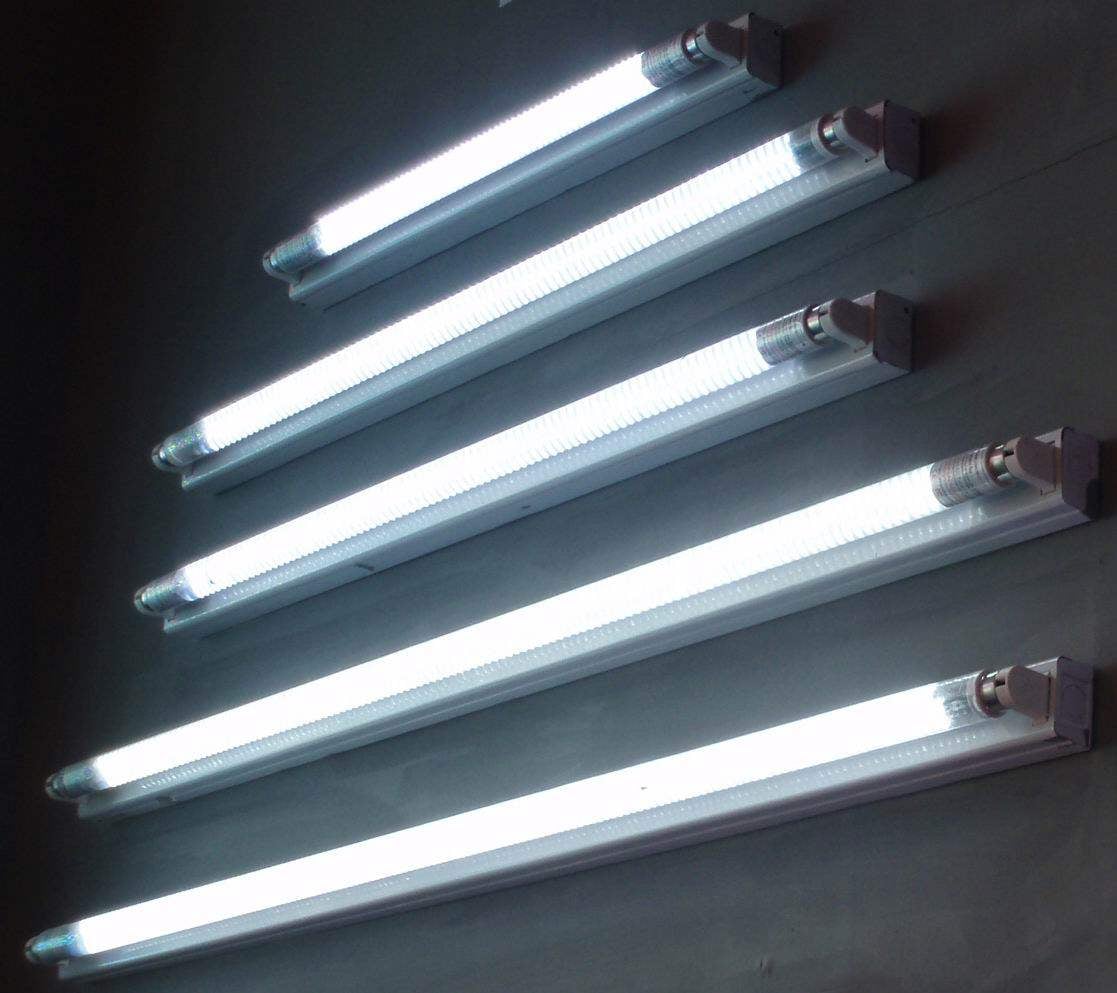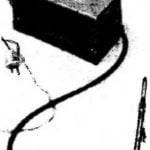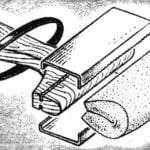 Fluorescent light (LDS) are widely used today in various industries and in everyday life. Unfortunately, the durability of LDS is extremely low. Their weak spot — helix required for the ignition of the phosphor inside the lamp at the time of inclusion. Two of them — from both ends of the lamp, and if even one of them burn out, to include LDS with the standard circuit (containing inductor, capacitor and starter) is impossible. In such a situation it is necessary to change the blown bulb with a new one. Therefore, where there are a large number of lamps (for example, in manufacturing plants, apartment buildings, stairwells and other similar cases), during the years of operation goes down and accumulates a lot of LDS with blown spirals.
Fluorescent light (LDS) are widely used today in various industries and in everyday life. Unfortunately, the durability of LDS is extremely low. Their weak spot — helix required for the ignition of the phosphor inside the lamp at the time of inclusion. Two of them — from both ends of the lamp, and if even one of them burn out, to include LDS with the standard circuit (containing inductor, capacitor and starter) is impossible. In such a situation it is necessary to change the blown bulb with a new one. Therefore, where there are a large number of lamps (for example, in manufacturing plants, apartment buildings, stairwells and other similar cases), during the years of operation goes down and accumulates a lot of LDS with blown spirals.
Them usually store, hoping in the future to start using some “magic” scheme another Kulibin. Over time, blown bulbs already accumulates countless, which leads to cluttering storage areas and unnecessary spending (and not small) for disposal of LDS, as this process is complex and labor-intensive.
This situation can be changed by using the proposed “magical” device that starts the fluorescent lamps even with a blown spirals. Moreover, in contrast to many published and popular designs, it is simple and reliable, since it contains only several parts. Through the use of rectifier assembled bridged, no need for dampening current and voltage resistor high power (as is customary in the known circuits).
Figure 1 shows the verified author of the electric circuit device to start and power the lights with LDS capacity from 20 to 80 watts. Moreover, as can be seen from the diagram, spiral lamp (with its ends) “shorted”, so it doesn’t matter what bulbs are used — new or used, with normal spirals or blown. Importantly, the power of LDS does not exceed 80 watts. In this scheme permitted the use of diodes with a reverse voltage of at least 300V, for example: КД105Б — КД105Г, Д112-16, КД2996В, КД2997, КД243Г, КД202Е and similar. For a more powerful pump will be required and the corresponding diodes of the rectifier bridge VD1 type Д231, Д242 to establish that it is necessary for the heat sink cooling area is not less than 50 cm2 each.

Fig. 1. Electric circuit device to supply the LDS with blown spirals
The device has passed the technical testing during the ten days of continuous operation with LDS Philips 40 watts.
Choke L1 — standard for luminaires LDS power up to 80 W, that is, any of the typical size of the VTA. If you intend to use bulbs with lower power, say 40 watts, it is permissible to use a different throttle with the marking on its body — VTA 36 W 220 V non-polar capacitor Sz is used for the relief of power interference. Its type can be anything, for example K73-24 (or foreign equivalent KWC) on the operating voltage of not lower than 300 V. non-polar capacitors C1, C2 of the same type, for example from the series K22-or similar, working voltage is 160 V or more. They give the device greater reliability and durability, preventing interference in the moments of firing of the phosphor in the LDS, however, these two elements can without consequences be deleted from the scheme. Lamp — domestic or imported (e.g. Philips) of the appropriate size and capacity from 20 to 80 V. the proposed scheme is designed to include only one lamp. So, if you want to run lighting, for example, on the production area a large area using multiple LDS, for each of them will need to collect a separate scheme.
LDS for aquarium
Selection of illumination for aquariums at first glance seems simple. The fact that for a given aquarium algae must be strictly regulated lighting: 20 W up to 100 L. In case the water quickly becomes cloudy and blooms, which is absolutely not desirable. Therefore, the approach to the selection of lights must be strictly individual.
However, available today in shops and markets lamps for aquariums with LDS generally similar, therefore, to adapt these to your specific aquarium, you need to make adjustments to the wiring diagram of LDS. For example, how to turn on only one lamp of the two provided for in the regular version? It is not difficult and even a novice hobbyist.

Fig. 2. The electric circuit of the lamp for aquariums with two (a) one and (b) LDS
Figure 2A presents a regular electrical circuit of the lamp for aquarium with two LDS and a separate triggering elements — starters. It shows that LDS are connected in series, not in parallel as incandescent bulbs. The resistance of one of the spiral LDS with power of 20 watts is 4 Ohm. To exclude one lamp (to reduce light) ordinary bypass grafting (resistor 3…5 Ohm) of the second spiral lamp with its subsequent removal from the lamp fails: remaining in the lamp light starts blinking and just annoy the users. To turn on this lamp one lamp instead of two prescribed, should be applied to the electric circuit shown in Fig.2B. All the electrical parameters of the elements and recommendations regarding effective use of devices similar to that described previously.
Why “blink” of LDS?
Serviceable LDS when enabled, usually one or two times will flash (inside the glass cylinder is used to ignite the phosphor) and light up a smooth white-milky light (therefore, these lamps are called lamp day light). If lamp included and in working mode continues to flash, as a rule, until then, until you turn off the power, — this indicates a malfunction of the starter is a problem in the AC voltage or the load resistance changes (capacity of LDS). This — below.
Removable components of fixtures (in stocks) such as the starter and the lamp are easily replaced with new ones. Non-polar capacitor in the circuit is included in the network 220 and prevents the passage of electrical interference from other devices included in the lighting network and produce a device running LDS. A smoothing capacitor rarely goes down, only with time there will be a small loss of capacity — 10…20% of nominal, which cannot be considered a serious fault.
Consider other elements, structurally included in the standard trigger is LDS, and their typical failures.
The throttle
The throttle in the launch device of LDS, proper operation of the lamp usually does not fail. Can happen the precipice (it is prosonly the ohmmeter) then the LDS do not light up, or a winding short circuit — then the inductor will be heated, melted paint coating and buzz. Thus, to ensure good throttle into the start circuit LDS is not difficult.
Starter
The starter is a vacuum discharger, the normally closed contacts which are opened under the influence of flowing an alternating current of a certain intensity to which this device is designed depending on the capacity of LDS (specified on the body of the barrel starter), and the nominal voltage is 220 volts, So the starter is designed to work with the LDS power of 25 W, cannot be used with a more powerful lamp, for example, 80-watt device will not work properly. That’s why LDS in the lamp blink when you replace the head on the other, with greater or lesser power.
At first the contacts of the starter closed and runs through the circuit, increasing current, causing warming up of the inner spiral of LDS. After ignition of phosphor inside the lamp current stabiliziruemost, between the contacts of the starter there is a large resistance, and the current decreases. Inside the barrel of the starter is in parallel with the contacts of the vacuum device is a non-polar capacitor of 0.01 UF. It protects from overload and arcing at the points of switching in the circuit.
Neon gas in the spark gap when the AC voltage (when resistance between the contacts is large) glows in pink light. This glow effect can be applied in other radio Amateur designs. The vacuum starter switch can act as a neon indicator bulb if used in series with current limiting resistance of 0.1 — 1 MW. While non-polar capacitor is removed.
Lamp
Classic LDS, as mentioned, has two helices located at the ends of the lamp, which at the time of switching the supplied voltage to run. After warming up of spirals (usually after 1 — 2) in the lamp strikes the phosphor and the tube glows; stabiliziruemost the current, and the voltage applied to the spirals of the lamp is reduced while maintaining low power consumption combined with good levels of light. If one or both spirals of LDS will burn out, in the first case the full firing of the phosphor does not occur and such lamp becomes unstable — flashing and the second is not lit at all. What to do with it — see above.
A. KASHKAROV, St. Petersburg



